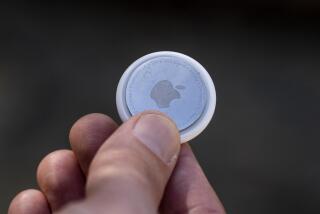Driver ticketed for using iPhone’s map app isn’t giving up yet
FRESNO — The Convicted Distracted Driver is sitting in a study carrel in the Cal State Fresno library, which, come to think of it, looks a little like a prison visiting room.
“I don’t relish that title,” said Steven Spriggs. “But that’s what I am.”
His crime: looking at his iPhone’s map application while driving.
Spriggs, 58, is director of planned giving for the college. He is gentle and soft-spoken. Or maybe that’s just because we are in the library.
Still, in his soft-blue dress shirt and gray tie, he looks more like an insurance salesman than a firebrand who sparked what court documents call a “media frenzy.” But that’s exactly what happened after Spriggs fought his conviction and lost.
“I believe in distracted driving laws with all my heart,” said Spriggs, whose 22-year-old son was badly injured twice by distracted drivers in 2010. “But police officers should have real probable cause to pull you over.”
On the evening he was ticketed, Jan. 5, 2012, Spriggs maintains he was driving safely. He was on his way home on California 41 in the middle of Fresno. Road construction forced the rush hour traffic to a stop. (Yes, big-city cynics, Fresno has a rush hour.)
Maybe there’s a way around this, thought Spriggs. It was dark. He picked up his phone and opened the map app. The glowing screen gave him away.
A California Highway Patrol motorcycle officer gestured at him to pull over. The officer’s foot was on the ground because traffic was stopped.
“Had I swerved or driven erratically, I would have gladly rolled over and paid the ticket because I screwed up,” Spriggs said. “I don’t drive dangerously, but I have been known to speed.” As a former competitive downhill skier, he said, “I seem to be in a hurry more than I’d like to be.”
At his traffic court trial, exactly a year ago, he opened a big map. “I could have done this,” he said. “Or,” he said picking up his phone, “I could have done this.” The commissioner was unmoved: “You could have also pulled over.”
Spriggs lost, and filed an appeal. Last month, he learned he lost that too.
“The statute prohibits driving ‘while using a wireless telephone’ except when the phone is ‘specifically designed and configured to allow hands-free listening and talking, and is used in that manner while driving,’” wrote Judge Kent Hamlin of Fresno County Superior Court’s Appellate Division. “It is undisputed that appellant used his wireless telephone while holding it in his hand as he drove his vehicle.”
That’s when the frenzy began. Can you read an email? Look at your clock? Hold the phone to use the voice texting function?
It depends, said CHP spokeswoman Fran Clader. “If someone says, ‘I was taking the phone out of my pocket and putting it on the seat,’ an officer might say, ‘OK, drive along.’ If they were entering something in the GPS system, that is communication, and that could be interpreted as breaking the law.”
Curiously, both she and Spriggs noted: It is legal to enter a phone number while driving. Judge Hamlin wrote that this “illogical and arbitrary” quirk should be addressed by the Legislature.
In the meantime, distracted driving, which caused 3,331 deaths nationwide in 2011, generates big money. In 2012, the state Department of Motor Vehicles reported nearly 450,000 handheld cellphone and texting convictions. A year ago April, which is Distracted Driving Awareness Month, more than 57,000 tickets were issued. At $159 a pop, and $279 for subsequent tickets, that’s a minimum of $71.5 million in annual revenue for the state.
The state has an interest in keeping the revenue spout on, Spriggs said. “All the people giving tickets have a great incentive to keep doing it, but the law needs to be enforceable and have common sense attached to it.”
Clader said the law is for safety: “Distracted driving is killing people.”
Gesturing to his phone, Spriggs said, “If you are holding a hamburger, you are fine. If you are holding this little box, you are not.”
That may be true. But according to a CHP spreadsheet Clader shared, eating-related distractions are involved in a sizable chunk of California traffic accidents, though not as many as phone-related distractions.
As word of Spriggs’ case spread, dozens of people offered to chip in for another appeal. “I got email from people passionate about this: ‘You are the Chosen One.’ ‘You must take this issue forward.’ ”
A Fresno appellate attorney offered to take on the case. “I understand the policy behind distracted driving, but my whole position here is that I don’t think the statute applies to this particular set of circumstances,” said attorney Scott Reddie. “It would be helpful to have some clarification so everyone can know what the law is.”
As it happens, Reddie has a particular interest in these laws. About 15 years ago, he was ticketed when spied eating a hamburger while driving. (In-N-Out. Of course.) The officer claimed Reddie had both hands off the wheel, holding a burger and a drink. Reddie produced his receipt, proving he did not have a drink. The judge dismissed the ticket.
The Convicted Distracted Driver will find out in a couple of weeks whether California’s 5th District Court of Appeal will hear his challenge.
I can’t decide if I’m rooting for Spriggs or not.
Like a lot of Californians, I believe that all drivers should turn off their cellphones, lock them in the trunk and retrieve them only when they’ve arrived at their destinations.
All drivers, that is, except for me.
More to Read
Start your day right
Sign up for Essential California for news, features and recommendations from the L.A. Times and beyond in your inbox six days a week.
You may occasionally receive promotional content from the Los Angeles Times.







